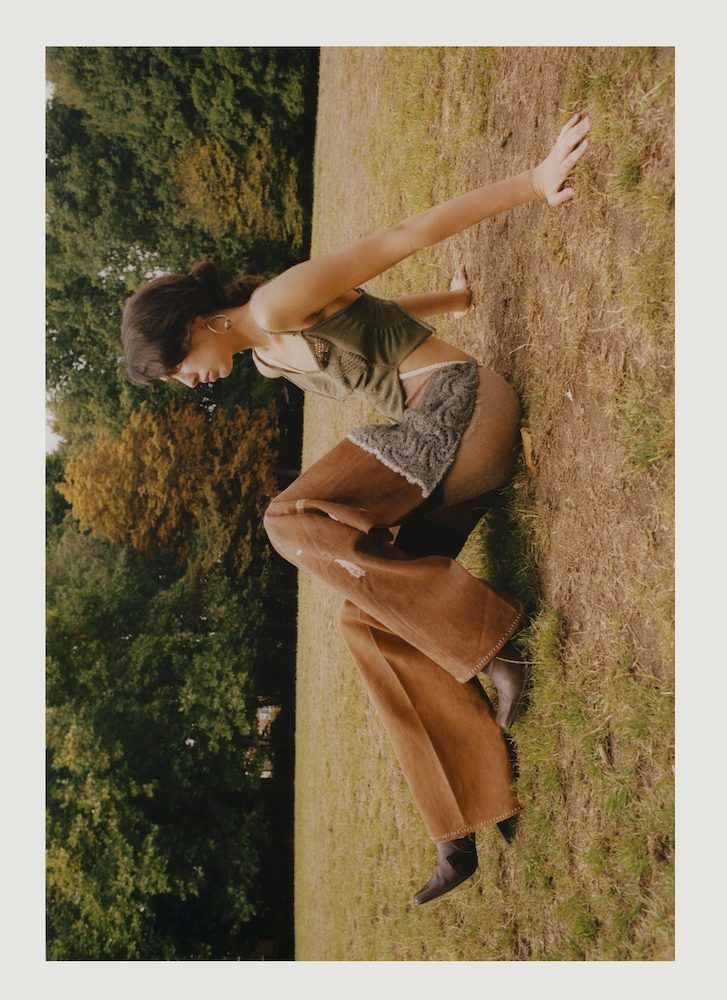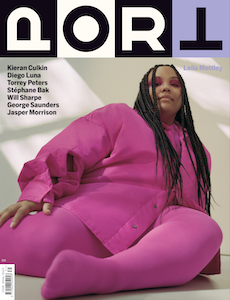The next generation of sustainable fashion designers

Sillage: it’s a word used in perfumery to describe what is left behind when you walk by. The impact — it’s what keeps people talking when you leave the room. In fashion, making an impression is everything. A good outfit should “change the way you walk; change the way you see yourself in car windows,” Central Saint Martins graduate Alec Bizby tells me. The main task of a fashion designer is to provide the wearer with impact — glamour, sexiness, absurdity — but this is rarely conducive to having a lack of impact on the planet. Fashion is silly, whilst sustainability is serious (rightly so, on both accounts). The pairing is often uncomfortable, like sitting on a bar stool while wearing a very short skirt. But designers Marie Lueder, Rina Hayashi and Alec Bizby manage to resolve this conflict.

With a desire for the “highest amount of creativity with the lowest amount of environmental impact”, Bizby’s entire MA collection cost no more than £100, made entirely from “thrifted curtains, curtain linings and bed sheets.” The used fabric came with its own personality – “stains, rips, wear and tear all add to the beauty of the final garments” – and what emerged was a process that instead of hindering Bizby’s creativity, enhanced it. “Thrifting material means you have to make changes to your plans… It keeps the designs fluid until the final stitch.” Bizby draws inspiration from historical peasant clothing and farmers’ workwear, folk dancing costumes and Welsh ladies’ hats. All pieces are one-of-a-kind, with Bizby having no intention of creating duplicates. “My final goal is to have a tiny brand that makes one-off pieces for people, which can then be turned into something else afterwards.” He believes this approach is the way to a sustainable future for fashion, but nothing will change unless large corporations begin to make proper steps towards sustainable practices. “They have to be dedicated to sustainability root and branch, small changes within these huge companies are not enough to make a difference. Capitalism and profit will turn this planet to ashes.”


Also abandoning mass production and focusing on traditional Japanese craftsmanship, Rina Hayashi’s Central Saint Martins’ BA collection inhabits a space between clothing and the unexpected sculptural forms that appear in everyday objects. During a road trip across her native Japan, Hayashi became “fascinated by traditional crafts rooted in each area.” The resulting garments feature dead-stock and second-hand materials from both Japan and the UK (rice paper, sasawashi paper and bamboo for garment construction, alongside British hand-spun merino wool and viscose) and a focus on techniques that are rapidly being forgotten. “For my sakabukuro chaps, I up-cycled 50-60 year old Japanese seamless bags which are used for making sake”, she tells me. Hayashi sourced the bags from her grandfather’s family, and dyed them using kakishibu, a traditional persimmon tannin varnish which continues to which continues to darken over time when exposed to sunlight, highlighting the beauty within the ageing process, and Hayashi’s love for the old and used. Garments are already ‘fixed’ before being broken or aged — “I use the ikkan-bari technique on my sculptural pieces which is a traditional way to fix bamboo baskets, like darning on the basket with rice paper.” For Hayashi, sustainable practice is linked with taking care of what is already existing and the ability to repair and remake from already used materials — she loves knitwear for its inherent flexibility (it can be deconstructed, re-knitted, and “reborn as new”). Hayashi’s grandmother was a freelance knitter, encouraging and pushing Hayashi with her BA collection when the designer wanted to give up, but it was their talks that Hayashi valued the most — ultimately, they were “just girls who love knitting.”

“As I grew up in the countryside,” notes Marie Lueder, “I feel very connected to nature and mother earth in a spiritual way and think about the loss of the connection between Gaia and us humans.” Lueder considers the environment throughout every level of her design process – using CLO 3D instead of paper or calico in order to prototype, up-cycling and using dead-stock – while also balancing the emotional and physical desires of her customers. The outcome of a practice that centres “passion rather than survival, asking rather than knowing”, Lueder’s clothes are intended as physical creations that provide the wearer with the “mental armour for their survival — for every day and our future.”

Lueder began up-cycling during the first lockdown of 2020, taking model’s unwanted garments and creating fresh, one-off pieces. Lueder describes the restriction of up-cycling as a thrill: ‘You had just one chance to make the garments rather than working from scratch and making multiple toiles.” Lueder trained as a tailor at Hamburg State Opera, before studying at the RCA and going on to an accelerator programme for sustainable leadership at Cambridge University in 2021. Lueder believes up-cycling can be the way forward for the industry — “using what is already there but still feeding into that desire to buy something new.” I mention sillage, already knowing that Lueder created a perfume with Paul Guerlain and IFF; what impact does she want her garments to have? “I want the people to gather, to be able to rethink and regenerate (gender, bodies…) if they feel scared and depressed about the future. A super positive and exited outlook into their future… that’s what I want them to feel.”

Photography Pablo Escudero
Styling Julie Velut
Casting Ethan Price
Hairstyling Tommy Taylor
Make up Iga Wasylczuk
Models Harry at Head Office MGMT, KC at Head Office MGMT, Medea at TIDE Agency

This article is taken from Port issue 31. To continue reading, buy the issue or subscribe here




